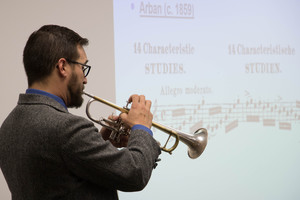Shuler explains the lineage and mechanics of the trumpet

CHADRON – The trumpet has been used for communication for centuries and still is, according to Dr. Sid Shuler. In his Graves Lecture Series Tuesday night, Shuler, a Chadron State College music faculty member and band director, presented the historical development of the instrument.
He demonstrated a sheep’s horn and 10 other types of trumpets, including his 3-year-old daughter’s made of PVC, and a natural trumpet he handmade during the summer of 2015. He said the trumpet often communicates to an ensemble the style and volume of the music.
Shuler, who earned his doctorate in trumpet performance and literatures at the University of Illinois, Urbana-Champaign, explained the mechanics of trumpets and how vent holes in the Baroque trumpet were the first concerted attempt to correct earlier errors in pitch and tone. He also briefly discussed sound waves and the physics involved in playing a trumpet.
"I could think about the mechanics of each note and be a perfect trumpet player but that would make me a terrible musician,” Shuler said, referring to the more refined nature of solo and ensemble performances.
Shuler focused on how the music written for trumpet often reflects its historic use in military and royalty fanfares, which is not typically melodic. During the Civil War, trumpets led the charge and the bell faced backward so the troops could hear the notes. Shuler played several selections demonstrating that the trumpet is often paired with drums resulting in a military sound.
The 1814 invention of valves, ubiquitous in modern brass instruments, allowed the trumpet access to more chromatic notes, according to Shuler.
During a Q&A session after his presentation, Shuler invited participants to play a trumpet and several took advantage of the opportunity.
When asked how old he was when he became interested in the trumpet, Shuler said he was about 10 and was drawn to it because it had only three buttons and was loud.
Category: Campus News, Graves Lecture Series, Music, Sandoz Society
